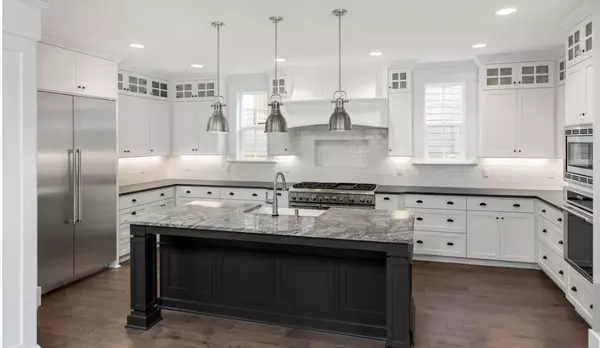
When It Comes to Color, Hallways Matter
While you probably invest a lot of time and research into choosing paint colors for the various rooms in your home—from the kitchen to the living room to the bedroom—odds are you haven’t given much thought to the hallways. According to design experts, however, whether small or expansive, hallways play an important transitional role in your home, connecting your interior look and feel from room to room in order to present a cohesive and stylish design scheme. With that in mind, Better Homes & Gardens consulted with professional color experts and designers to curate some of the very best color choices for your hallways. The general rule of thumb is to first consider your floor plan, they say, choosing a neutral color like taupe, cream or gray to seamlessly integrate open floor plan layouts. Homeowners should also take their furnishings and other decor into consideration to choose a complementary hallway color. Here are some of the best color choices to maximize the design potential of your hallways: Platinum by Behr: A light gray shade that also exudes warmth. Platinum is infused with subtle greenish-blue tones that helps create a serene atmosphere while passing through hallways. Rabbit’s Ear by Glidden: Designers say this shade is as soft and cozy as its namesake. A warm griege with a touch of cool tonality, Rabbit’s Ear’s ashy hue skews it a bit toward the gray spectrum. This versatile shade serves as a great transitional tone for blue and cream. White Dove by Benjamin Moore. A shade that will work in most any home, White Dove is described as a true white with appealing warm undertones. This bright and inviting color is particularly well-suited for smaller, closed-off hallways, helping to open up the space and avoid a cave-like atmosphere. Toasted Almond by Glidden. Beige often gets a bad rap for being boring, which makes choosing the right shade of the utmost importance. Designers say Toasted Almond is one such choice, imbued with hints of caramel and bronze that add all-important interest. The color works nicely with natural wood tones, and plays well with both modern and traditional design schemes. Tamarind by Benjamin Moore. If your hallways are part of an open-plan design or feature interesting architectural elements, you might want to opt for a richer color such as Tamarind. The rich mushroom hue of this color will help give your home decor a grounded feeling, while its deeper nature helps highlight details like arches and moldings. Choosing the right paint color for your hallways will elevate your home’s design and add interest to this often overlooked space.

Decorating Tips for Each Room of the Home
Do you ever wish someone would come in and tell you exactly what to do in every room of your house? Consider this guide your blueprint to doing just that. Read on for your room-by-room decorating manual. BedroomA bedroom should be a place of solace, rest and relaxation. Its creation should be intentional, focused on function and complemented by a soft, calming aesthetic. Eliminate clutter: A bedroom retreat should be a serene and calm space, which you can accomplish by starting with a blank canvas. Before bringing in anything new, remove clutter from surfaces and corners. Create the layout: Space planning will help you create the best layout to maximize space, comfort and relaxation. The bed, rug, bedside tables, dressers, other storage pieces, seating options and wall decor should all be considered as you design the floor plan. Select a color palette: The room’s color scheme will create a cohesive look. The 60-30-10 rule is a tried-and-true way to achieve a harmonious color palette ( 60% of the room should be the primary color, 30% should be a secondary color, and 10% should be an accent color). Add something soft underfoot: One of the most essential qualities of a relaxing bedroom is softness, so be sure the rug is large enough to extend beyond both sides of the bed. Layer the window treatments: Creating an optimal sleep environment starts with a dark room. Blackout shades or curtains will block the light and be a design element. Choose lighting: Various types of lighting will add ambiance and create a soothing space. A statement piece, such as a chandelier, sconces or table lamp, will let you control the level of lighting you want. Home OfficeA home office should help you feel inspired, calm and empowered. Turning your home office into a space where you want to retreat can transform it from a space where you watch the clock to a room that feels like your own oasis. Select lighting: Sunlight is a natural mood booster, which can be necessary during long work days. Ensuring ample sunlight can come through the windows will boost energy and even help you concentrate better. A mix of desk lamps, floor lamps, sconces and art lights can let you control the lighting level depending on the time of day and the type of project you’re working on. Reimagine the furniture: A traditional desk doesn’t always need to be included in a home office. For example, a round dining table instead of a desk creates an elegant look and a more flexible space. If you prefer to be more comfortable during long days of calls and spreadsheets, having a place to lounge, such as a sofa or a chaise lounge, may be best for you. Have a video call background: If you spend your day on video calls, creating a background can highlight your professional brand. Wallpapering a wall in your home office, having the correct lighting in place and styling bookcases to showcase the items that represent your best self will help you appear more professional. Include ample storage: Open shelving is perfect for displaying items that reflect your interests that may not otherwise have a space within your home. Alternatively, closed shelving is ideal for files, folders and other miscellaneous items. Add soundproof accents: Soundproofing your office can help reduce outside distractions. Wall-to-wall carpeting, layering rugs, installing draperies and hanging framed art and photographs are all ways to muffle sounds. Living RoomA living room’s layout, colors, style, lighting, accessories and more are all essential factors in creating a thoughtfully designed gathering, hosting and relaxing space. Determine the function: Whether it’s a space for the family to gather for movie nights, a room to entertain guests or an area to play and relax, establishing the function of the space is the foundation for how the whole room will come together. Create the layout: Space planning will help you create a functional and helpful layout that maximizes the space. Thorough measurements of the room will help you assess where the furniture should go, how large the rug should be, where to hang art and other design decisions. Select the furniture: The best starting points are the rug and the sofa. The rug can help set the aesthetic for the room, and the sofa is typically the largest and most significant piece of furniture. Once those two primary pieces are selected, you can choose additional seating, tables and accent pieces. Layer in lighting: Every room should have a variety of lighting, including ambient, task and accent lighting. This could blend overhead lighting, table and floor lamps and wall sconces. Accessorize the room: Accessorizing the room is the final step. The most interesting spaces combine personal items, meaningful art, subtle family photographs and accessories collected over time. Dining RoomA formal dining room can be the most beautiful room in the home. However, you may only use it several times a year. Rethinking how you use this space can be the key to making it more functional. Make it casual: If you host sit-down meals semi-regularly and want to keep your dining room, you can make the room more approachable and casual for a space you use more often, even gathering around the table for weeknight dinners. Design an office: The furniture should be multifunctional, with your dining room being an office by day and a dining room by night. The dining table can turn into a desk, with the correct desk chair, computer, table lamp and other workday necessities. Installing built-ins or mobile storage can easily conceal your workday essentials after the workday is over. When it’s time to set the table, you can easily reposition the dining chairs, tuck away your workday items, drape the tablecloth, set the tablescape and watch this room transform into an entertaining destination. Set up a game room: For the household that loves gathering to play your favorite games, setting up several game tables instead of a dining room can create a space for family game nights or even larger game nights when you host friends and family. Use the same chairs at the different game tables for a cohesive look and to seamlessly transition these chairs to dining chairs. If you need to use the space for a dining room, you can push the tables together, drape a tablecloth, set up the chairs and it will look like a complete dining set. Create a cocktail lounge: If you prefer swanky sips over a sit-down supper, transform your dining room into a cocktail lounge. Envelop the space in a moody, dark paint color and dark, textured wallpaper. Sleek yet comfortable seating and soft, warm lighting will create a space where you can entertain or escape during a quiet night at home.

Smart Home Technology to Cool Down at Home
During the dog days of summer, beating the heat can feel all-encompassing. With the help of home technology, you can cool your home down quickly and efficiently. Incorporating smart home technology, such as smart lighting, thermostats and window treatments, can help you have a more comfortable summer. Read on for the smart home technology your house needs to stay cool and comfortable when the temperatures reach an all-time high. Smart ThermostatA smart thermostat lets you control your home’s temperature even when you’re not home. When you leave for the day, you can adjust the temperature to save energy, and prior to your arrival home, you can cool down your home from your smartphone. This allows you to save on your summer energy usage while still being comfortable at home. Smart LightingWith smart lighting, you can control your home’s lighting from your smartphone. Like a smart thermostat, you can keep the lights off when no one is home but turn them on before your arrival home. Or, if you’re on vacation, you can program the lights to turn on and off sporadically throughout the day and evening so it appears someone is home. Automated Blinds and ShadesSmart window treatments can help block out the sun’s intense rays, which can quickly heat a home. Automated blinds and shades will allow you to close the window treatments during the hottest time of the day, even if you’re not home. Or, you can automate the blinds and shades to close when the sun shines the brightest into your home. This can help prevent the heat from building up and keep the house cool without turning down the air conditioning. Smart Irrigation SystemAutomating your exterior watering will help you stay cool by avoiding the heat altogether. An automated irrigation system will allow you to check this home maintenance task off your list. You can program the system to water your lawn and landscaping so you can be confident that your yard will stay lush and you’ll stay cool. Bedroom Hydration StationStaying hydrated is imperative when you’re trying to cool down. Having a hydration station in your bedroom will help keep staying hydrated at the top of your mind. A built-in beverage refrigerator or water dispenser will save the trip downstairs, making you more inclined to refill your water glass. Smart Ceiling FanInstalling a smart ceiling fan that is wi-fi enabled can allow you to efficiently cool down a room through your smartphone or Alexa device. Turning on the fan before you come home or in another room can provide a refreshing place to sit back, relax and cool down. Smart VentA smart vent is an HVAC vent that can help control your home’s temperature, which is ideal during the hot summer months. Smart vents can sense activity in the room and adjust the temperature based on the room usage.
Categories
Recent Posts










